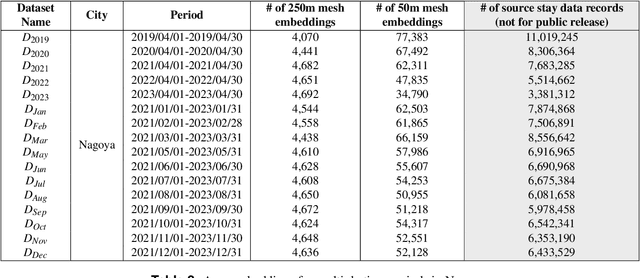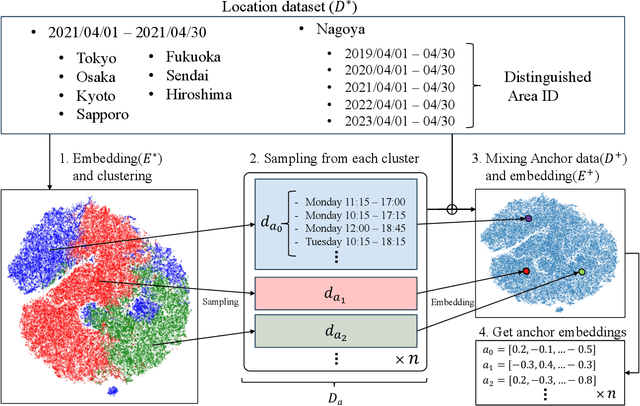Kazuyuki Shoji
OpenUAS: Embeddings of Cities in Japan with Anchor Data for Cross-city Analysis of Area Usage Patterns
Jul 29, 2024



Abstract:We publicly release OpenUAS, a dataset of area embeddings based on urban usage patterns, including embeddings for over 1.3 million 50-meter square meshes covering a total area of 3,300 square kilometers. This dataset is valuable for analyzing area functions in fields such as market analysis, urban planning, transportation infrastructure, and infection prediction. It captures the characteristics of each area in the city, such as office districts and residential areas, by employing an area embedding technique that utilizes location information typically obtained by GPS. Numerous area embedding techniques have been proposed, and while the public release of such embedding datasets is technically feasible, it has not been realized. One of the obstacles has been the integration of data from different cities and periods into a unified space without sharing raw location data. We address this issue by developing an anchoring method that establishes anchors within a shared embedding space. We publicly release this anchor dataset along with area embedding datasets from several periods in eight major Japanese cities. This dataset allows users to analyze urban usage patterns in Japanese cities and embed their urban dataset into the same embedding space using the anchoring method. Our key contributions include the development of the anchoring method, releasing area embedding datasets for Japanese cities, and providing tools for effective data utilization.
Area Modeling using Stay Information for Large-Scale Users and Analysis for Influence of COVID-19
Jan 19, 2024Abstract:Understanding how people use area in a city can be a valuable information in a wide range of fields, from marketing to urban planning. Area usage is subject to change over time due to various events including seasonal shifts and pandemics. Before the spread of smartphones, this data had been collected through questionnaire survey. However, this is not a sustainable approach in terms of time to results and cost. There are many existing studies on area modeling, which characterize an area with some kind of information, using Point of Interest (POI) or inter-area movement data. However, since POI is data that is statically tied to space, and inter-area movement data ignores the behavior of people within an area, existing methods are not sufficient in terms of capturing area usage changes. In this paper, we propose a novel area modeling method named Area2Vec, inspired by Word2Vec, which models areas based on people's location data. This method is based on the discovery that it is possible to characterize an area based on its usage by using people's stay information in the area. And it is a novel method that can reflect the dynamically changing people's behavior in an area in the modeling results. We validated Area2vec by performing a functional classification of areas in a district of Japan. The results show that Area2Vec can be usable in general area analysis. We also investigated area usage changes due to COVID-19 in two districts in Japan. We could find that COVID-19 made people refrain from unnecessary going out, such as visiting entertainment areas.
 Add to Chrome
Add to Chrome Add to Firefox
Add to Firefox Add to Edge
Add to Edge